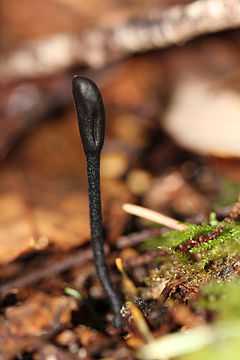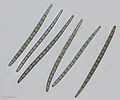Trichoglossum
| Trichoglossum | |
|---|---|
 | |
| Trichoglossum hirsutum | |
| Scientific classification | |
| Kingdom: | Fungi |
| Division: | Ascomycota |
| Subdivision: | Pezizomycotina |
| Class: | Geoglossomycetes |
| Order: | Geoglossales |
| Family: | Geoglossaceae |
| Genus: | Trichoglossum Boud. (1885) |
| Type species | |
| Trichoglossum hirsutum (Pers.) Boud. (1907) | |
| Species | |
Trichoglossum is a genus of fungi in the family Geoglossaceae. They are commonly called hairy earth tongues. The type species is Trichoglossum hirsutum.[1]
Members of the genus Trichoglossum have tiny hairs known as setae on the spore bearing surface. The related genus Geoglossum lacks hairs on the spore bearing surface.
History
The genus Trichoglossum was created by Émile Boudier,[2] who constructed the new genus to include species of Geoglossum bearing prominent setae. Numerous authors have examined this genus since its creation,[3][4][5] with many new species and varieties described. Index Fungorum currently lists 47 names, including forms and varieties, while Kirk et al. (2008)[6] acknowledge 19 species. Published molecular phylogenetic research also supports the genus as a well-supported clade.[7][8][9]
Location
Trichoglossum species are found in woodlands in North America and Europe, as well as Asia,[4] Australasia,[10] India,[11] and South America.[12][13]
-

Trichoglossum hirsutum spores 400x phase contrast
-

Trichoglossum hirsutum spores 400x brightfield
External links
- Trichoglossum at Mushroom Observer -
- Index Fungorum Trichoglossum record -
- California Fungi - Trichoglossum hirsutum -
- Key to Club Fungi in the PNW -
References
- ↑ "Index Fungorum - Trichoglossum Genus".
- ↑ Boudier, É. 1885. Nouvelle classification naturelle des Discomycetese charnus connus generalement sous le nom de Pezizales. Bulletin Societe Mycologique de France 1: 91–120.
- ↑ Durand, EJ. 1908. The Geoglossaceae of North America. Annales Mycologici 6: 387–477.
- ↑ 4.0 4.1 Imai S. 1941. Geoglossaceae Japoniae. Journal of the Faculty of Agriculture, Hokkaido Imperial University 45: 155–264.
- ↑ Mains EB. 1954. North American Species of Geoglossum and Trichoglossum. Mycologia 46: 586–631.
- ↑ Kirk PM, Cannon PF, Minter DW, Stalpers JA. 2008. Dictionary of the Fungi, 10th ed. CAB International, Wallingford, UK.
- ↑ Sandnes ACS. 2006. Phylogenetic relationships among species and genera of Geoglossaceae (Helotiales) based on ITS and LSU nrDNA sequences. Cand. Scient. Thesis. The University of Oslo, Norway
- ↑ Schoch CL, Wang Z, Townsend JP, Spatafora JW. 2009. Geoglosomycetes cl. nov., Geoglossales ord. nov. and taxa above class rank in the Ascomycota tree of life. Persoonia 22: 129–138.
- ↑ Hustad VP, Miller AN, Moingeon J-M, Priou J-P. 2011. Inclusion of Nothomitra in Geoglossomycetes. Mycosphere 2: 646–654.
- ↑ Spooner BM. 1987. Helotiales of Australasia: Geoglossaceae, Orbiliaceae, Sclerotiniaceae, Hyaloscyphaceae. Bibliotheca Mycologica 116: 1–711.
- ↑ Maas Geesteranus RA. 1965. Geoglossaceae of India and Adjacent Countries. Persoonia 4(1): 19–46.
- ↑ Gamundi I. 1979. Subantarctic Geoglossaceae II. Sydowia 32: 86-98
- ↑ Hladki AI, Romero AI. 2009. La familia Geoglossaceae s. str. (Helotiales) en la provincia de Tucumán (Argentina). Boletín de la Sociedad Argentina de Botánica 44 (3-4): 249–255.